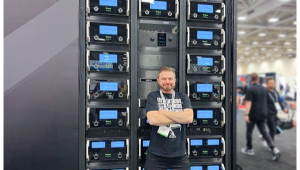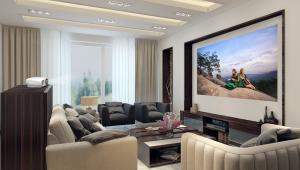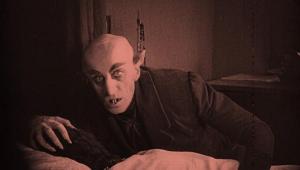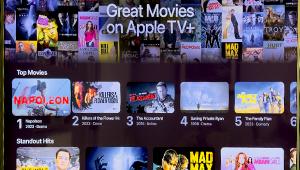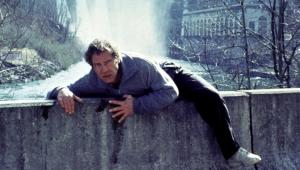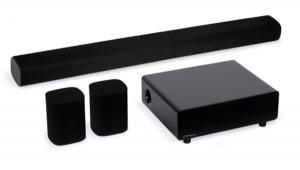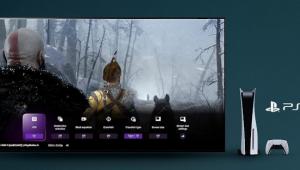First Listen: Dolby Atmos Is "Right" At Home Page 2
Onkyo and Pioneer both had active Atmos demos at CE Week. Onkyo used Triad-built Atmos speakers, set up on stands at the front and back of the seating area for their 5.2.4 Atmos System. Pioneer used their own just announced Elite speaker package designed by Andrew Jones, positioned very similarly. Unlike either the Triads or the prototype Onkyo speakers displayed in Onkyo's room, which used a single full-range driver on top, the Jones design fires up via the same new two-way concentric mid-tweeter driver that's used on the speaker's front baffle. Jones explained to me that, although a single full-range driver pointing up is Dolby's minimum spec, primarily to preserve space on the speaker top while achieving the required low-frequency range, a matching concentric driver in the same space should allow for a more cohesive soundfield.
I can't say I heard any significant difference between the two demos with the limited Atmos material on hand. Along with some impressive Atmos trailers designed to show off the technology that sounded about the same on both systems, the content provided by Dolby included a couple of clips from Life of Pi and another from Star Trek Into Darkness. Onkyo showed the big storm scene from Pi in which the cargo ship capsizes, while Pioneer demo'd the opening scene from Into Darkness in which Kirk and Bones are chased through a jungle by primitive, red-faced natives while Spock is dropped into the mouth of an erupting volcano. In both cases, surround effects were clearly coming from above me from places where I knew speakers did not exist, though I found the Life of Pi demo more convincing and exciting, a difference I attribute largely to how the films were mixed. Unquestionably, though, the ceiling-generated information added a dimension to the surround sound that was obvious and, to my ears, a notable enhancement.
So, What Could Be Bad?
About those caveats: although I'm excited by the potential of what I heard in the Atmos demos, if I were a typical consumer, I'd probably wait for the expert reviews before rushing out to preorder a full Atmos system. Some of that just comes from prudency that should be attendent to the introduction of any new technology. To begin with, it wasn't clear that either Onkyo or Pioneer were using one of their own receivers to decode the Atmos soundtrack, and although it's unlikely production AVRs would behave any differently than a professional decoder, I'd like to confirm that before passing judgement. Nor do we know yet just how much Atmos-encoded software will come to market, and what the new AVRs will do to make effective use of the extra ceiling channels when faced with a non-Atmos soundtrack from either Dolby or DTS.
More critically, I was a bit troubled by some of the subtleties of what I heard in both demo rooms, namely, the tendency for surround effects to be more localizable to the rear speakers than what I'm used to hearing in a well adjusted 5.1 or 7.1 system, particularly those that use dipole surrounds precisely to counter this common phenomenon. A lot of action seemed to be jumping at me from right off the speaker baffles behind me, and I soon realized why. In placing the Atmos surround speakers immediately behind the listening area, they were apparently optimized to best acheive an enveloping height effect. But that speaker position no longer best served the primary surround channels as well as a traditional side-wall arrangement might. And it also seemed to me to make the experience somewhat more dependent on listening position. For example, Onkyo's room featured two rows of seats, and when I leaned forward from the back row-center position during the demo to where the head of the listener in front of me might have been, I heard the localizing effect at the rear diminish slightly.
It's possible that small differences in set-up levels or other parameters could minimize this tendency for the rear effects to get sticky with the speakers, or that dipole designs that integrate the up-firing driver could help alleviate it, or that dedicated up-firing Atmos speakers could be installed separately at those positions that best deliver the ceiling effect while the side and possibly back surround speakers get to stay exactly where they do their own best work. Or, it's possible that a home theater with built-in ceiling speakers would deliver such a superior Atmos experience to any reflected installation that it's the only real option to be considered by the serious enthusiast. These are things we won't know until all the pieces come to market this fall and we can begin testing the different arrangements.
But in the meantime, I'm optimistic. From the minute I heard Atmos for movie theaters, I wondered how long it would take to bring it to home theaters. Now I know.
More Dolby Atmos News:
Dolby Atmos Movie-Theater-Sound Technology Heading to Home Gear
Pioneer Showcases Dolby Atmos-Enabled Receivers and Speakers
- Log in or register to post comments


Thanks for the overview! I'll trying Atmos when I get a chance.
I tend to get fewer and higher quality components, I don't see spending $2000 to $3000 per pair as being really affordable nor adding that much to the experience. I'm already pleased with my 5.1 experience, my theater room is rather small for additional channels, I have ceiling absorption treatment to prevent ceiling reflections from mains and surrounds and can't imagine removing them would enhance the sound since I experienced improvements when adding them. Gimmick or not, I'll be willing to try a demo when a good one gets installed at my local Magnolia, or elsewhere...I just called Magnolia in Seattle and they currently have no plans for an Atmos demo room, that's not that they won't it's just not yet in they're plans yet.
I checked with my local Regal and they have an Atmos equipped theater but it's a price premium and not all movies in it are Atmos and there are no designations on the theater listings to indicate that the movie showing in that theater is Atmos. If they make it this difficult to try I don't see how it's going to catch on.
Thanks again. I don't mean to sound negative I'd like to try Atmos but I'm having trouble doing so.
Cheers!

Excellent points made, both by you and the article author. In another thread - I wasn't trying to execute Atmos, but I know it's not for everyone.

Dolby or another manufacturer may say that timbre-matching is not critical, but I bet such a statement would be at least partially driven by the desire to not scare anyone away from buying into Atmos. Regardless of what Dolby or anyone else says, it seems to be a good idea to have all your speakers in a system timbre-matched as much as possible. If the content in the height channels is potentially full-bandwidth, and if it will at times involve panning from the fronts to the heights to the backs, timbre-matching is at least as important as it would be for your traditional surrounds.
I personally would not implement an Atmos system at home that compromises the seamless sound quality I have with my traditional system. That just doesn't make sense to me. So, for any such system I would set up, it would be actual on-ceiling speakers (not sound reflected off the ceiling) and it would be all speakers from the same manufacturer and line for the best possible match, with additional EQ as necessary to deal with the issues created by having speakers against a room boundary.

According to The Nielsen Company, over 85% of Blu Ray are encoded in DTS HD Master. Unless the movie studios are switching, (think high switching cost), to Dolby True HD with Atmos encoded Blu Ray, there will be very few contents available. Of course, Dolby can add a "simulated" Atmos like all the other useless surround modes to the receiver so that the receiver can still be using the ceiling speakers regardless of audio encoding.
I love the Dolby's idea, but DTS will most likely come up with something similar to keep the movie studios from switching. DTS will probably sell s software upgrade to movie studio to make it work, (think low switching cost).

Incidentally, the AMC, Atmos-equipped ETX theater near me has dropped the ETX designation and now calls itself Prime. The latter has added reclining seats and seat shakers (fortunately the latter are not turned up to 11), and is still Atmos-equipped. One irony, however, is that when The Hobbit (the first one) came out in high frame rate, it played in both the (pre-Prime conversion) ETX house and the adjoining IMAX auditorium. But the high frame rate was only playing in the latter, and Atmos only in the former. So you had to choose between high frame rate and conventional multichannel sound or Atmos with the standard frame rate. Of course, this was near LA. Readers in more conventionally equipped areas, perhaps with no IMAX, ETX (or Prime), high frame rate, or Atmos capability are mumbling "Poor Baby!" :-) I feel your pain, since I may soon be moving to an area no nearly so well endowed.

Great.
After agonizing for the last month I was ready to buy a AVR and a surround speaker system for my brand new HT. I was settling between Triad, SVS and ascend and Denon 4000
THen I heard about the Atmos....
Now what? The AVR and speakers were the last component needed to finish off the theater,,,If I am going to purchase something now, I sure would like it to utilize Atmos technology if feasible.
ANy suggestions on how to proceed....I was really looking to get the sound purchased this week...sheesh!..LOL

I'd be interested to know which 200 titles are now Atmos (does Dolby have this listed?), because seeing The Hobbit in it was a revelation. Though the film itself wasn't very notable, the HFR and Atmos made it a completely immersive experience unlike anything else I've experienced. So while I'm not slated for an upgrade anytime soon, this might give me a reason to rethink that.


Will dipole side channels work with Atmos? Mine are above ear level(by 2 feet) - should I use them for the back ceiling speakers? Can our receivers compensate for their position? What about a center speaker that is ABOVE the tv _ can't be mounted below in my setup. All these issues, if not addressed, will prevent the consumer from being in to Atmos.
I just downloaded a Denon manual for the top-of-the-line Atmos receiver, and their setup information is SAD. Not a good start.



